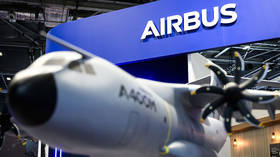First real $20k hoverboard can fly 6 mins & takes 6 hours to recharge (VIDEO)

With Arca Space’s hoverboard prototype the world has finally came closer to inventing a somewhat flying "board" capable of lifting a person above any type of ground and transporting them over "distances."
While Back to the Future II fans might finally rest after acquiring the Romanian company's creation, their new state of the art technology comes with a heavy price-tag of around $20,000.
Marty McFly fans might also be disappointed with Arca Space’s hoverboard, that looks more like a flying mattress rather than hardware Tony Hawk would use.
The need to create such a large surface area seems apparent, as the devise deploys 36 fans to lift the board off the ground, by generating 195kg of downward thrust.
Yet the battery can only power the device for a maximum of six minutes, quite disappointment for those willing to splash out tens of thousands of dollars on the flying machine.
The battery problems are supposed to be compensated by the 272 horsepower used to lift the board. But then again, the devise requires a six-hour charge in-between your hovering adventures. However, you can purchase the ArcaDock accessory that will charge the battery in just 35 minutes for an extra $4,500.

The ArcaBoard comes in two varieties — an Enhanced Thrust model which supports a rider weighing up to 110kg for about three minutes, and a Long Endurance model which can support a rider that weighs up to 80kg for up to six minutes.
To steer this "revolutionary breakthrough transportation" at top speed 20km/h one needs a smartphone, to enable the stabilization system. When the stabilizer is turned off, the board is controlled by shifts in the rider’s center of gravity.
The board is made of aerospace-grade composite materials, and weighs about 80kg, and will go on sale in April of next year.
READ MORE: Easy rider: Much-anticipated Lexus hoverboard swooshes in action (VIDEO)
The AcraBoard also triumphs where its rival makers have failed, due to its ability to ride over all terrains. The Hendo hoverboard only operates on non-ferromagnetic surfaces – those which are not attracted to magnets, while just hovering an inch off the ground, it can easily run into trouble if any unexpected bumps or objects appear.
Luxury carmaker Lexus has also entered the hoverboard market, making a product that is powered by magnets and liquid nitrogen, and constructed of natural bamboo. However, the company has admitted that the hoverboard only works on certain terrains such as non-ferrous, highly conductive surfaces like copper or aluminum.












